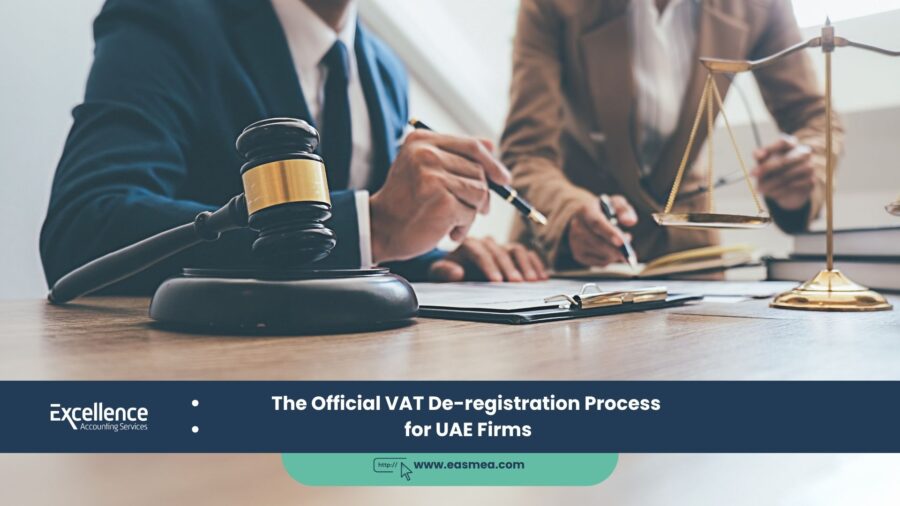The Official VAT De-registration Process for UAE Firms
In the lifecycle of a business, change is the only constant. Companies evolve, pivot, or sometimes, cease operations. Just as the UAE tax law mandates VAT registration for businesses crossing a certain turnover threshold, it also outlines a strict, formal process for de-registration when those conditions no longer apply. This is not an optional administrative task; it is a legal obligation with significant financial consequences if ignored.
- The Official VAT De-registration Process for UAE Firms
- Understanding the "Why": Mandatory vs. Voluntary De-registration
- The De-registration Journey: A Step-by-Step Guide
- Record-Keeping: Your Post-De-registration Obligation
- What Excellence Accounting Services (EAS) Can Offer
- Frequently Asked Questions (FAQs)
- Ensure a Smooth and Compliant VAT De-registration.
Failing to de-register from VAT on time can lead to a hefty penalty of AED 10,000, and can complicate the process of company liquidation or sale. A clean exit from the tax system is crucial for a clean closure of business affairs. This guide provides a definitive framework for the official VAT de-registration process in the UAE. We will cover the mandatory and voluntary conditions, the critical deadlines you cannot afford to miss, the step-by-step application process, and the ongoing responsibilities you have even after your Tax Registration Number (TRN) is cancelled.
Key Takeaways for VAT De-registration
- Two Key Scenarios: De-registration is either mandatory (e.g., business closure) or voluntary (e.g., turnover falls below the mandatory threshold).
- Strict Deadline: An application must be submitted within 20 business days of the event that triggers the need to de-register.
- Hefty Penalties Apply: Failure to apply for mandatory de-registration on time results in an AED 10,000 penalty.
- Clear All Dues: The Federal Tax Authority (FTA) will not approve a de-registration application until all outstanding VAT returns are filed and all tax liabilities are paid.
- Record-Keeping Continues: After de-registration, you are still legally required to maintain all tax-related records for a minimum of five years.
Understanding the “Why”: Mandatory vs. Voluntary De-registration
The first step is to determine if you are eligible or required to de-register. The law provides two clear pathways.
1. Mandatory VAT De-registration
A business must apply for de-registration in the following situations:
- Ceasing Taxable Supplies: The company stops making taxable supplies and does not intend to make any in the next 12 months. This is the most common reason, typically triggered by company liquidation, cessation of trading activities, or a complete change in business model to only making exempt supplies.
- Turnover Falls Below Voluntary Threshold: The total value of the company’s taxable supplies (and imports) over the previous 12 months is less than the voluntary registration threshold of AED 187,500. The company must also not anticipate exceeding this threshold in the next 30 days.
In these cases, de-registration is not a choice. The 20-business-day clock starts ticking from the moment these conditions are met. For example, if a trade license is cancelled on October 1st, the de-registration application is due within 20 business days from that date.
2. Voluntary VAT De-registration
A business may apply for de-registration if it meets these two conditions:
- Turnover Falls Below Mandatory Threshold: The total value of the company’s taxable supplies over the previous 12 months is less than the mandatory registration threshold of AED 375,000.
- 12 Months of Registration Completed: The company has been registered for VAT for at least 12 months.
This option provides flexibility. A business whose turnover has declined might choose to de-register to reduce its administrative burden of quarterly filing. This is a strategic decision that should be carefully considered with help from a business consultancy professional.
The De-registration Journey: A Step-by-Step Guide
Navigating the de-registration process requires a methodical approach to ensure all legal requirements are met.
Step 1: The Pre-Application Health Check
Before you even log into the EmaraTax portal, you must ensure your house is in order. The FTA will reject applications if there are outstanding issues. Your checklist should include:
- File All Overdue Returns: Ensure every single VAT return from your registration date to the present has been submitted.
- Settle All Liabilities: Pay all outstanding VAT due and any administrative penalties in full. Your account with the FTA must be clear.
- Final Accounts Preparation: Prepare your accounts up to the date you ceased trading or met the de-registration criteria. This is essential for filing the final VAT return. A final accounting review is highly recommended.
Step 2: The EmaraTax Application
The application itself is submitted online via the EmaraTax portal.
- Login and Navigate: Access your company’s EmaraTax account. On the dashboard, select “VAT” and you will find an option for “VAT De-registration.”
- Complete the Form: The online form is dynamic. You will be asked to select the reason for de-registration (mandatory or voluntary) and provide the effective date.
- Provide Supporting Documents: You must upload evidence to support your reason. Common documents include:
- For business closure: Trade license cancellation, letter of liquidation from official liquidators.
- For reduced turnover: Financial statements for the last 12 months, a detailed turnover declaration.
- Submit for Review: Double-check all information before submitting. The FTA will review the application and may request further clarification.
Step 3: The Final VAT Return and Deemed Supplies
Upon submitting your application, you must file a final VAT return for the tax period ending on your de-registration date. This return is unique because it must include tax on “deemed supplies.”
A deemed supply occurs when you dispose of business assets on which you previously claimed input tax. The law requires you to pay output VAT on the market value of any remaining stock, plant, and machinery. This is to ensure you don’t gain an unfair tax advantage by recovering VAT on assets that are no longer being used for making taxable supplies. This calculation can be complex and is a common area for errors.
Record-Keeping: Your Post-De-registration Obligation
De-registration does not end your relationship with the FTA. You are legally required to maintain all business records, tax invoices, credit notes, and ledgers for a minimum of five years after your de-registration date (this extends to 15 years for real estate records).
A cloud accounting platform like Zoho Books is invaluable for meeting this obligation. It ensures your entire financial history is securely archived and instantly accessible. Should the FTA conduct an audit of a period when you were registered, you can retrieve the necessary records, including the FTA Audit File (FAF), with a few clicks, avoiding penalties for poor record-keeping.
What Excellence Accounting Services (EAS) Can Offer
The VAT de-registration process is fraught with potential pitfalls, from missed deadlines to incorrect final return calculations. EAS provides a seamless, expert-led service to ensure your exit from the VAT system is compliant and penalty-free.
- Complete De-registration Management: We handle the entire process on your behalf, from the initial assessment of eligibility to preparing the application, submitting documents, and liaising with the FTA until approval is granted.
- Final VAT Return Filing: Our tax experts will accurately calculate your final VAT liability, including the complex calculation for deemed supplies on remaining assets, ensuring you pay the correct amount. This is a core part of our VAT return filing service.
- VAT Health Check: Before applying, we can perform a comprehensive internal audit of your VAT history to identify and resolve any potential issues that could delay your application.
- Liquidation Support: Our team works alongside official liquidators, providing the necessary financial reports and tax clearance required for a smooth company closure process.
Frequently Asked Questions (FAQs)
The most common reason for rejection is having outstanding liabilities. The FTA will not process a de-registration request if there are any unpaid VAT amounts or administrative penalties on the account. The second most common reason is providing insufficient supporting documentation for the reason for de-registration.
You must act immediately. You are already in breach of the law. You should prepare and submit the de-registration application as soon as possible, along with all supporting documents like the trade license cancellation. You should expect to receive the AED 10,000 penalty for late application. It is advisable to seek professional help to manage communication with the FTA.
Yes. The sale of business assets is a taxable supply. You must charge 5% VAT on the sale price of these items and report this output tax on your final VAT return. If you are not selling them but keeping them for personal use, they are treated as a “deemed supply,” and you must account for VAT on their current market value.
Yes. If your taxable supplies exceed the mandatory registration threshold of AED 375,000 in any 12-month period, you are legally required to apply for VAT registration again within the specified timeframe.
You need to provide clear financial evidence. This would typically be in the form of monthly sales reports or management accounts for the last 12 consecutive months, demonstrating that the total taxable turnover was below the threshold. Your submission should be clear and well-documented.
Once submitted with all correct information and supporting documents, and assuming all dues are cleared, the FTA generally takes around 20-30 business days to review and approve the application. However, if they require additional information, the process can take longer.
The effective date is the date from which you are no longer considered a registrant. For business closures, it’s typically the date the business ceased to exist. For a drop in turnover, you can propose a date. The FTA will confirm the final effective date upon approving your application. You must continue to meet all VAT obligations until this date.
No. You are entitled to claim a refund for any recoverable input tax on your final VAT return. If your input tax for the final period is greater than your output tax (including tax on deemed supplies), your final return will be in a net refundable position.
No, an individual company cannot de-register from VAT while it is part of a Tax Group. The company must first apply to be removed from the Tax Group. Once removed, its VAT status is assessed on a standalone basis. If it then meets the criteria for de-registration, it can apply separately.
No. VAT and Corporate Tax are separate tax types with their own registration and de-registration processes. While the underlying reason for de-registering from both might be the same (e.g., company liquidation), you must submit two separate de-registration applications on the EmaraTax portal, one for each tax type.
Conclusion: A Clean Exit is a Smart Exit
The VAT de-registration process is a critical final step in the tax compliance journey for any closing or downsizing business in the UAE. It is governed by strict rules and deadlines that carry significant financial penalties if overlooked. By understanding your obligations, preparing meticulously, and following the official procedure, you can ensure a smooth, compliant exit from the VAT system. This proactive approach protects you from future liabilities and allows for a truly final and clean closure of your business’s tax affairs.




